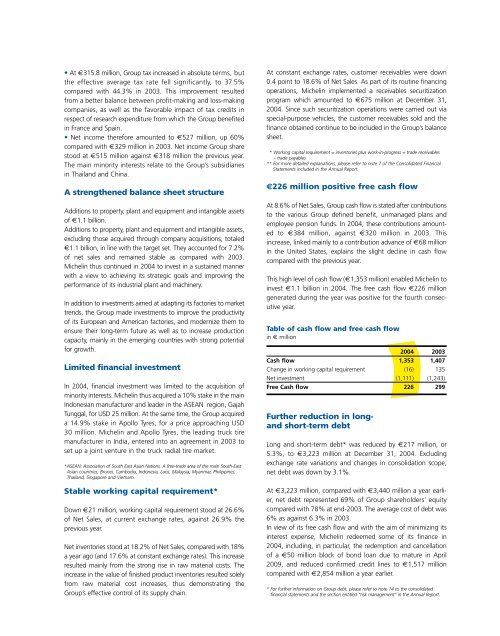Michelin couv courteGB
Michelin couv courteGB
Michelin couv courteGB
You also want an ePaper? Increase the reach of your titles
YUMPU automatically turns print PDFs into web optimized ePapers that Google loves.
• At €315.8 million, Group tax increased in absolute terms, but<br />
the effective average tax rate fell significantly, to 37.5%<br />
compared with 44.3% in 2003. This improvement resulted<br />
from a better balance between profit-making and loss-making<br />
companies, as well as the favorable impact of tax credits in<br />
respect of research expenditure from which the Group benefited<br />
in France and Spain.<br />
• Net income therefore amounted to €527 million, up 60%<br />
compared with €329 million in 2003. Net income Group share<br />
stood at €515 million against €318 million the previous year.<br />
The main minority interests relate to the Group’s subsidiaries<br />
in Thailand and China.<br />
A strengthened balance sheet structure<br />
Additions to property, plant and equipment and intangible assets<br />
of €1.1 billion.<br />
Additions to property, plant and equipment and intangible assets,<br />
excluding those acquired through company acquisitions, totaled<br />
€1.1 billion, in line with the target set. They accounted for 7.2%<br />
of net sales and remained stable as compared with 2003.<br />
<strong>Michelin</strong> thus continued in 2004 to invest in a sustained manner<br />
with a view to achieving its strategic goals and improving the<br />
performance of its industrial plant and machinery.<br />
In addition to investments aimed at adapting its factories to market<br />
trends, the Group made investments to improve the productivity<br />
of its European and American factories, and modernize them to<br />
ensure their long-term future as well as to increase production<br />
capacity, mainly in the emerging countries with strong potential<br />
for growth.<br />
Limited financial investment<br />
In 2004, financial investment was limited to the acquisition of<br />
minority interests. <strong>Michelin</strong> thus acquired a 10% stake in the main<br />
Indonesian manufacturer and leader in the ASEAN region, Gajah<br />
Tunggal, for USD 25 million. At the same time, the Group acquired<br />
a 14.9% stake in Apollo Tyres, for a price approaching USD<br />
30 million. <strong>Michelin</strong> and Apollo Tyres, the leading truck tire<br />
manufacturer in India, entered into an agreement in 2003 to<br />
set up a joint venture in the truck radial tire market.<br />
*ASEAN: Association of South East Asian Nations. A free-trade area of the main South-East<br />
Asian countries; Brunei, Cambodia, Indonesia, Laos, Malaysia, Myanmar, Philippines,<br />
Thailand, Singapore and Vietnam.<br />
Stable working capital requirement*<br />
Down €21 million, working capital requirement stood at 26.6%<br />
of Net Sales, at current exchange rates, against 26.9% the<br />
previous year.<br />
Net inventories stood at 18.2% of Net Sales, compared with 18%<br />
a year ago (and 17.6% at constant exchange rates). This increase<br />
resulted mainly from the strong rise in raw material costs. The<br />
increase in the value of finished product inventories resulted solely<br />
from raw material cost increases, thus demonstrating the<br />
Group’s effective control of its supply chain.<br />
At constant exchange rates, customer receivables were down<br />
0.4 point to 18.6% of Net Sales. As part of its routine financing<br />
operations, <strong>Michelin</strong> implemented a receivables securitization<br />
program which amounted to €675 million at December 31,<br />
2004. Since such securitization operations were carried out via<br />
special-purpose vehicles, the customer receivables sold and the<br />
finance obtained continue to be included in the Group’s balance<br />
sheet.<br />
* Working capital requirement = inventories plus work-in-progress + trade receivables<br />
– trade payables<br />
** For more detailed explanations, please refer to note 7 of the Consolidated Financial<br />
Statements included in the Annual Report.<br />
€226 million positive free cash flow<br />
At 8.6% of Net Sales, Group cash flow is stated after contributions<br />
to the various Group defined benefit, unmanaged plans and<br />
employee pension funds. In 2004, these contributions amounted<br />
to €384 million, against €320 million in 2003. This<br />
increase, linked mainly to a contribution advance of €68 million<br />
in the United States, explains the slight decline in cash flow<br />
compared with the previous year.<br />
This high level of cash flow (€1,353 million) enabled <strong>Michelin</strong> to<br />
invest €1.1 billion in 2004. The free cash flow €226 million<br />
generated during the year was positive for the fourth consecutive<br />
year.<br />
Table of cash flow and free cash flow<br />
in € million<br />
2004 2003<br />
Cash flow 1,353 1,407<br />
Change in working capital requirement (16) 135<br />
Net investment (1,111) (1,243)<br />
Free Cash flow 226 299<br />
Further reduction in long-<br />
and short-term debt<br />
Long and short-term debt* was reduced by €217 million, or<br />
5.3%, to €3,223 million at December 31, 2004. Excluding<br />
exchange rate variations and changes in consolidation scope,<br />
net debt was down by 3.1%.<br />
At €3,223 million, compared with €3,440 million a year earlier,<br />
net debt represented 69% of Group shareholders’ equity<br />
compared with 78% at end-2003. The average cost of debt was<br />
6% as against 6.3% in 2003.<br />
In view of its free cash flow and with the aim of minimizing its<br />
interest expense, <strong>Michelin</strong> redeemed some of its finance in<br />
2004, including, in particular, the redemption and cancellation<br />
of a €50 million block of bond loan due to mature in April<br />
2009, and reduced confirmed credit lines to €1,517 million<br />
compared with €2,854 million a year earlier.<br />
* For further information on Group debt, please refer to note 14 to the consolidated<br />
financial statements and the section entitled “risk management” in the Annual Report.


